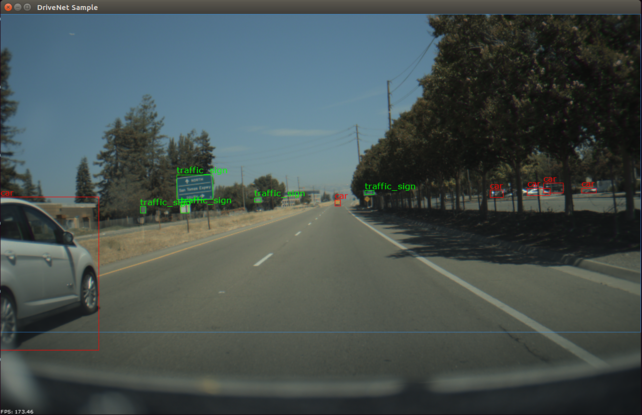- Welcome
- Getting Started With the NVIDIA DriveWorks SDK
- Modules
- Samples
- Tools
- Tutorials
- SDK Porting Guide
- DriveWorks API
- More
The NVIDIA® DriveNet sample is a sophisticated, multi-class, higher- resolution example that uses the NVIDIA® DriveNet proprietary deep neural network (DNN) to perform object detection.
The DriveNet sample application detects objects by performing inferences on each frame of a RAW video or camera stream. It clusters these objects with parameters defined within the sample application.
A follow-up algorithm clusters detections from both images to compute a more stable response.
The DriveNet sample, sample_drivenet, accepts the following optional parameters. If none are specified, it performs detections on a supplied pre-recorded video.
./sample_drivenet --input-type=[video|camera|cameraCustom]
--video=[path/to/video]
--camera-type=[camera]
--camera-group=[a|b|c|d]
--camera-index=[0|1|2|3]
--cameraCustomString=[camera-parameter-string]
--slave=[0|1]
--precision=[int8|fp16|fp32]
--useCudaGraph=[0|1]
--stopFrame=[frame]
--enableUrgency=[0|1]
--stateless=[0|1]
Where:
--input-type=[video|camera|cameraCustom]
Defines if the input is from live camera or from a recorded video.
Live camera is supported only on NVIDIA DRIVE(tm) platforms.
It is not supported on Linux (x86 architecture) host systems.
Default value: video
--video=[path/to/video]
Specifies the absolute or relative path of a raw, lraw or h264 recording.
Only applicable if --input-type=video.
Default value: path/to/data/samples/lraw/AR820_RGGB_8MP_v10.lraw
--camera-type=[camera]
Only applicable if --input-type=camera.
Default value: ar0231-rccb-bae-sf3324
--camera-group=[a|b|c|d]
Is the group where the camera is connected to.
Only applicable if --input-type=camera.
Default value: a
--camera-index=[0|1|2|3]
Indicates the camera index on the given port.
Default value: 0
--cameraCustomString=[camera-parameter-string]
Parameter string for custom cameras.
Only applicable if --input-type=cameraCustom
Default value: camera-name=SF3324,interface=csi-a,link=0,output-format=processed
--slave=[0|1]
Setting this parameter to 1 when running the sample on Xavier B accesses the camera
on Xavier A.
Applicable only when --input-type=camera.
Default value: 0
--precision=[int8|fp16|fp32]
Defines the precision of the DriveNet DNN. The following precision levels are supported.
- int8
- 8-bit signed integer precision.
- Supported GPUs: compute capability >= 6.1.
- Faster than fp16 and fp32 on GPUs with compute capability = 6.1 or compute capability > 6.2.
- fp16 (default)
- 16-bit floating point precision.
- Supported GPUs: compute capability >= 6.2
- Faster than fp32.
- If fp16 is selected on a Pascal GPU, the precision will be set to fp32.
- fp32
- 32-bit floating point precision.
- Supported GPUs: Only Pascal GPUs (compute capability 6.1)
- Default for Pascal GPUs.
When using DLA engines only fp16 is allowed.
Default value: fp16
--useCudaGraph=[0|1]
Setting this parameter to 1 runs Drivenet DNN inference by CUDAGraph if the hardware supports.
Default value: 0
--stopFrame=[number]
Runs DriveNet only on the first <number> frames and then exits the application.
The default value for `--stopFrame` is 0, for which the sample runs endlessly.
Default value: 0
--enableUrgency=[0|1]
Enables the object urgency prediction by a temporal model.
Only supports predicting the urgency for cars and pedestrians on the front camera with 60° field of view.
Default value: 0
--stateless=[0|1]
Setting this parameter to 0 runs the stateful temporal model. Setting it to 1 runs the stateless temporal model.
The stateful model uses all past frames to predict urgency, while the stateless model only uses the most recent frames.
Only applicable if --enableUrgency=1.
Default value: 0
./sample_drivenet --input-type=video --video=<video file.raw>
./sample_drivenet --input-type=camera --camera-type=<camera type> --camera-group=<camera group> --camera-index=<camera idx on camera group>
where <camera type> is a supported RCCB sensor. See Cameras Supported for the list of supported cameras for each platform.
On NVIDIA DRIVE™ platforms, you can run DriveNet on DLA engines with the following command line:
./sample_drivenet --dla=1 --dlaEngineNo=0
./sample_drivenet --video=<video file.raw> --stopFrame=3000
./sample_drivenet --precision=int8
./sample_drivenet --enableUrgency=1
The sample creates a window, displays a video, and overlays bounding boxes for detected objects. The color of the bounding boxes represents the classes that the sample detects, as follows:
When urgency prediction is enabled, the predicted urgency value is displayed behind the object class name. The color of the bounding boxes represents urgency value with a green, white, red smoothly transitioned color map. In this color map, green indicates negative urgency, white indicates zero urgency, and red indicates positive urgency.
